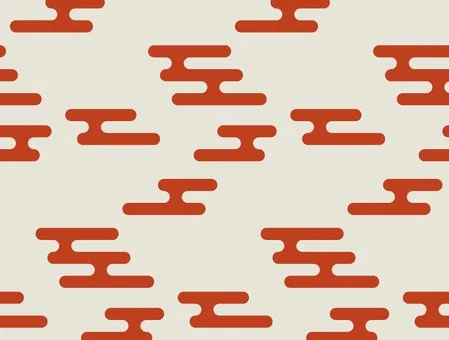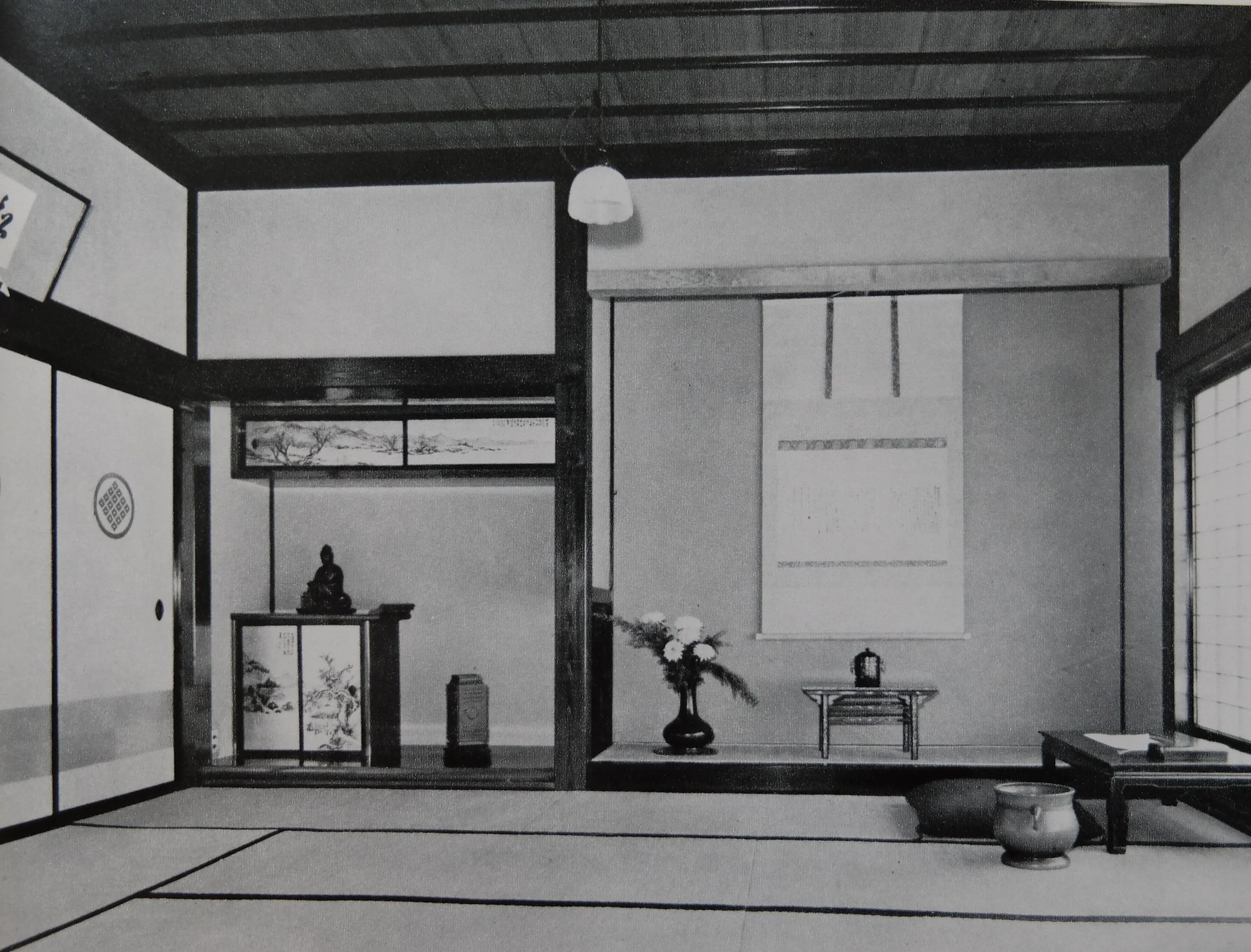Like the tokonoma, the toko-waki (床脇, lit. ‘toko flank’) is an alcove, but where the tokonoma is purely ornamental, the toko-waki combines an ornamental role with functionality. As the name suggests, the toko-waki is located next to the tokonoma and in the same wall; it is on the other side of the tokonoma to the shoin. The toko-waki typically contains some combination of upper suspended cupboards or cabinets (tenbukuro todana 天袋戸棚, lit. ‘heaven bag door shelf’), an open shelf (tana 棚) or shelves, and lower cabinets (chibukurotodana 地袋戸棚, lit. ‘earth bag door shelf’).
In this modern zashiki, the tokonoma (床の間) is between the toko-waki (床脇) and the shoin (書院), which is conventional, but there is also a closet (oshi-ire 押入) in the same wall, which detracts from the shoin-toknoma-tokowaki composition.
The toko-waki also shares with the tokonoma a likely origin in the residences of Buddhist priests (sо̄bо̄ 僧房, lit. ‘priest chamber’), specifically in the shelves used to store sutras (kyо̄kan 経巻). It has also been suggested that the toko-waki began as a two-tier shelf used to hold everyday items, or as a piece of moveable furniture something like the ‘fan shelf’ (sensu-dana 扇子棚) that eventually evolved into a built-in permanent fixture. The toko-waki is decorated with various craft items, and is also a place to store the valuable works of art, vases, etc. that are displayed in the tokonoma.
A ‘fan shelf’ (sensu-dana 扇子棚).
Elements of the toko-waki labelled: the upper cabinet or cupboard (ten-bukuro 天袋) and ‘head’ (kamoi 鴨居), staggered shelves (chigai-dana 違棚) with ‘shrimp post’ (ebi-tsuka 海老束) and ‘brush return’ (fude-kaeshi), lower cabinet (ji-bukuro 地袋) with sill (oki-jikii 置敷居) and half-post or end-post (hо̄date 方立 or han-tsuka 半束), and ‘ground board’ (ji-ita 地板),
The design of the toko-waki is extremely free, and there are over a hundred different ‘templates’ (hinagata 雛形). A single shelf (tana 棚) running the full width of the tokowaki is called a tо̄shi-dana (通し棚, lit. ‘passing shelf’) or hitomoji-dana (一文字棚, lit. ‘one character shelf’, from its resemblance to the character hito 一). The shelf style most commonly associated with the toko-waki is known as chigai-dana (違い棚, ‘staggered shelf’): two shelves arranged one above the other and offset in a ‘mist pattern’ (kasumi-gata 霞型).
Mist pattern (kasumigata 霞型).
In this style, a turned-up strip of moulding called a (fude-kaeshi 筆返し, lit. ‘brush return’) is attached to the end of the upper shelf, which is supported off the lower shelf by a vertical piece called the ebi-tsuka (海老束, lit. ‘shrimp post’). Other styles include han-dana (半棚, ‘half shelf’), tsuka-tana (束棚, ‘post shelf’), tsuri-dana (釣り棚, ‘fishing shelf’), and sumi-tana (隅棚, ‘corner shelf’). Similarly, the cabinets may run the full width of the toko-waki, or be half-width. The rear wall of the toko-waki might contain a window in any number of styles.
Elements of the chigai-dana (違棚): ‘brush return’ (fude-kaeshi 筆返し) with ‘stop’ (tomari とまり) and ‘pigeon breast’ (hato-mune 鳩胸), ‘shrimp post’ (ebi-tsuka 海老束).
In minka, the toko-waki might be absent, with the tatami floor extended to the wall; alternatively, there may be a Buddhist altar (butsudan 仏壇), or, in more recent minka, a closet (oshi-ire 押入) occuppying the alcove in place of the toko-waki. Sometimes the walls surrounding the tokotoma and toko-waki are not earth walls (dokabe 土壁) or plaster-finished, but are lined with paper of the same kind as is used on the thin opaque sliding partitions called fusuma (襖). This style is called hari-tsuke (貼付け, lit. ‘pasting’ ‘sticking’ or ‘attaching’), and is mainly found in higher-class residences.
A ‘Kansai style’ (Kansai-fū 関西風) zashiki with something of a sukiya-style (sukiya-fū 数寄屋風) flavour. The toko-waki is absent, or at least devoid of any of the elements of a typical toko-waki, and the tatami extends to the rear wall. Okuda family (Okuda-ke 奥田家) residence, О̄saka, an Important Cultural Property.
A fairly ‘classic’ zashiki layout with tokonoma, shoin, and tokowaki. Masuda family (Masuda-ke 増田家) home, Wakayama Prefecture, an Important Cultural Property.
This toko-waki has upper cabinet (ten-bukuro) and a half-width lower cabinet (ji-bukuro) with fude-kaeshi. Sakurai family (Sakurai-ke 桜井家) residence, Ishikawa Prefecture
A contemporary zashiki with a minimal toko-waki (left), marked only by its floor board and low ‘ceiling’.
The tokonoma and toko-waki (out of frame to the right) in this zashiki are paper-hung (hari-tsuke 貼付け), as evidenced by the visible rippling in the paper in the tokonoma.









